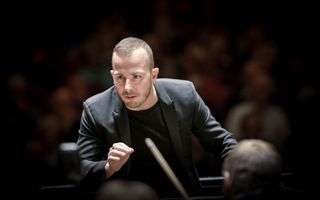|
Back
The Russians Were Coming! New York
Isaac Stern Auditorium Carnegie Hall
06/07/2019 - & June 6, 8, 2019 (Philadelphia)
Igor Stravinsky: Funeral Song, Opus 5
Sergei Prokofiev: Piano Concerto No. 3 in C Major, Opus 26
Sergei Rachmaninoff: Symphony No. 1 in D Minor, Opus 13
Beatrice Rana (Pianist)
The Philadelphia Orchestra, Yannick Nézet-Séguin (Music Director/Conductor)

Y. Nézet-Séguin (© Hans van der Woerd)
“I feel like a ghost wandering in a world proven alien. I cannot cast out the old way of writing, and I cannot acquire the new. I have made intense efforts to feel the musical manner of today. But it will not come to me.”
Sergei Rachmaninoff (1873-1943)
Since French was the lingua franca of Tsarist Russia, nobody would look askance that Yannick Nézet-Séguin should shift gears from his MET Orchestra all-French program three nights ago to last night’s all-Russian music last night (most written under Tsar Nicholas II) with the Philadelphia Orchestra. Most enchanting was that–with the change of country and orchestra–Mr. Nézet-Séguin could give a sparkle and lift to both genres.
Two of the three hallmark composers were represented not with their best works, but relatively hidden gems. The third, Sergei Prokofiev was given the ultimate crowd-pleaser, with a soloist well worthy of her encore.
Mr. Nézet-Séguin worked with two adept but dissimilar orchestras. Earlier this week, his (yes, his!) MET Orchestra had been re-arranged with the cellos backing the first violins rather than having their own section on stage right. Thus, the Debussy and Ravel had a more...um, Impressionistic feel. Not a wavering or obscuring as a pointillistic background for moments of First Chair beauties. One was impressed both with the MET Orchestra as a whole, and those First Chair solos–trumpet, flute, clarinet–which pierced out of the darkness.
The Philadelphia Orchestra has been, ever since the Age of Stokowski, the ultimate ensemble orchestra. Those string consorts are luscious, the brass and winds of stunning glory. Mr. Nézet-Séguin is their director as well, and makes good use of this splendid ensemble.
They were shown at their best in the opening early Stravinsky Funeral Song, written for the death of Stravinsky’s teacher, Nicolas Rimsky-Korsakov. No, this wasn’t a ballet, though the calls of Firebird and even Sacre could be heard here. Rather, it was a pantomime set to music. The composer had imagined all the members of the orchestra proceeding past the casket, each of them contributing their musical tributes.
Funeral Song– discovered and uncovered four years ago–was given its New York first performance by Esa-Pekka Salonen two years ago, and its unfamiliarity was as interesting as the music. Under Mr. Nézet-Séguin, the work seemed to move with more volition, though it still seemed heavy (as funerals are apt to do!) The first string flurries would come out in Firebird (written two years later), and then one heard a more discrete litany, part Slavic, part Wagnerian. More “late” Stravinsky than the ballets, and worthy of reverence and respect.

B. Rana (© Marie Staggat)
The centerpiece last night was Prokofiev’s Third Piano Concerto. And for those used to the Argerich or Yuja Wang blockbusters, this was a revelation of another sort. Yes, Ms. Rana played those firework octaves with perfection, and Mr. Nézet-Séguin turned the Philadelphia Orchestra into a rocketship of colors.
But most impressive were the second movement theme and variations. Prokofiev’s love for the Classical era was unparalleled. The composer never needed those endless Stravinsky essays and Harvard lectures, merging his Art with his Craft (specifically Robert Craft). Prokofiev simply wrote tunes worthy of Haydn, with variations here worthy of Mozart. And this was how Ms. Rana handled her Steinway.
Adding to that was an encore of Chopin’s Opus 25, No. 2 Etude, where her perhaps excessive rubati gave another picture of this most sensitive artist.
The finale was the work over which composer Sergei Rachmaninoff had either writer’s block or a mental breakdown or both. And which sent him to an alienist (the old name for a shrink). Yet with Mr. Nézet-Séguin performing the First Symphony, one wonders what the temperament of 1895 critics could have been.
Glazunov, the first conductor, was a conservative composer at best, and perhaps he underplayed that opening brass crackle, perhaps he didn’t find the Dies Irae, and perhaps the critic César Cui had a weird vision of hell (where he wrote the Symphony should be played).
Never mind. Yannick Nézet-Séguin had no doubts of the crackling opening or the crazy end. And if parts of the middle movements lost some impetus, nothing is perfect. It was a good symphonic performance, it sped along at its best points, and–for this kind of program–emphasized Slavic moods and Slavic melodies.
Harry Rolnick
|